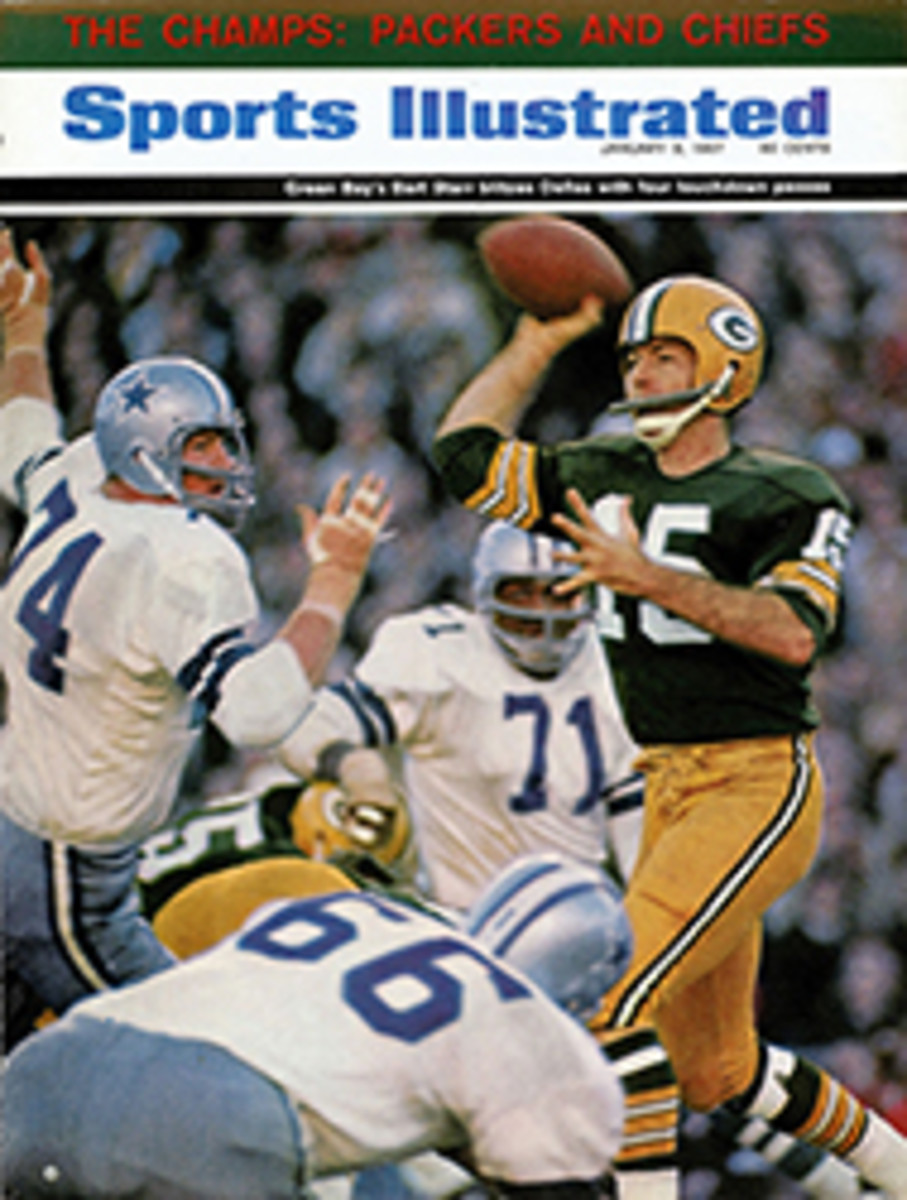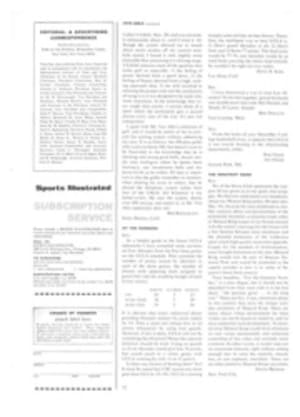
Cops, dogs and snowmobiles without snow
It took prime-time television a full season (39 weeks) to recount all the perils faced by the transcontinental travelers of Wagon Train who pushed their way from east to west back in the rough old days. But Wagonmaster Ward Bond and his friends could never even have guessed at the hazards that had to be overcome by two latter-day pioneers who tried to make the trip in the opposite direction in snowmobiles a month ago. Scooting across 4,018 miles of the North American continent from Vancouver, B.C. to South Portland, Me. in 24 days, James Langley of Blaine, Minn. and Clark Dahlin of nearby Cambridge faced no hostile Indians but plenty of hostile—or merely puzzled—bluecoats. Fourteen times, or once for every 287 miles they traveled, the snowmobilers were stopped, picked up or turned aside by cops along the route.
The Oregon Trail trekkers sometimes were beset by wolves. For Langley and Dahlin the hazard was dogs. Snowmobiles, some of which—significantly—are called Sno-Cats, ride so low to the ground that a dog, even a middle-sized dog, can look down on the driver. Moreover, a snowmobile skittering along and shooting up a fine spray of snow behind it impresses most dogs as mighty interesting quarry. All the way across Canada and the U.S. fine affectionate house dogs, long-known as well-mannered and beloved pets, came rushing wildly out of yards to try to gnaw on Langley and Dahlin.
The ultimate handicap faced by the two snowmobilers would never have been classed as such by the wagon-trainers: no snow. As a rule, most of Canada and the northern tier of the U.S. is covered with snow for a good part of each year. When Langley and Dahlin started from Vancouver on November 28 it was a rainy 38°, but soon afterward warm, glowing sunshine began to blanket the entire area. Wherever the snowmobiles went, the snow seemed to have just melted or be just about to fall. In anticipation of such an emergency, Langley and Dahlin had equipped their machines with several sets of auxiliary wheels to take over from the skis on which they usually run, but the pounding of the little wheels over corduroy roads created a collateral hazard. "Every 20 miles," said Dahlin, "the kidneys needed release. But every 20 miles or so it seemed cars would suddenly appear on all sides where originally there had been none." So to the ordeal of no snow there was added that of no privacy.
Langley and Dahlin originally had planned simply to set a new snowmobile distance record. They did not think that would be difficult. No one before them had ridden very far in a snowmobile. Clark Dahlin, 26 and married, is a tall, thin, dark-haired mechanic whose previous experience with snowmobiles was limited to using one on short trips near his home. Jim Langley is 29, married, and an excavating engineer in his working hours. He is a snowmobile racer in his spare time. Last winter he placed third in a 460-mile race from Winnipeg to St. Paul, the longest such event ever run. Both adventurers felt that a thousand-mile run would set a record that would be safe for a long time. But when they began to plot a course, they were increasingly entranced by the idea of racing over the snow from the Pacific all the way to the Atlantic. Harold Krull, part-owner of the Great North Trading Post and Dahlin's boss, persuaded Polaris Industries, Inc. to lend them two 15-horsepower Polaris Colt snowmobiles for the trip and persuaded another outfit to send along a supporting vehicle for emergencies. To qualify as automobiles, so they could run on roads when necessary, the snowmobiles were equipped with windshield wipers, dual headlights, taillights, a double braking system, turn signals, seat belts and Minnesota license plates, as well as those auxiliary wheels.
The license plates did not help much. Leaving Vancouver, after ceremoniously dipping their skis into the Pacific, the two were stopped at the entrance to the Deas Island Tunnel under the Fraser River by Canadian Mounties who said, with some reason, that snow never fell in the tunnel. Langley and Dahlin protested that their vehicle, carrying Minnesota plates, was legal on British Columbia roads. True, said the officers. But speed limits through the tunnel are a minimum of 45 miles an hour, and most motorists go through at 75 miles an hour. Could the snowmobiles make 45 miles an hour? To answer this tricky question, the litigants proposed a race. It was agreed that if the snowmobiles could keep up with police cars going 45 miles an hour on the open highway, they would be permitted to go through the tunnel. Snowmobiles accelerate very quickly. Langley and Dahlin got off to such a lead that it took the police cars three blocks to catch them, and the sporty Mounties waved the travelers on their way.
Meanwhile, the sunshine continued to fall. It was everywhere. The roads were plastered with it. It was piled in drifts on the mountains. It fell from the roofs of houses. The skies remained a threatening cloudless blue. Hoping to find what all snowmobile addicts look forward to—plenty of good, cold, biting winds to put a frosty crust on a snowfall—Langley and Dahlin turned south to the Cascade Range. But there was not even snow on the top of Stevens Pass. Langley and Dahlin were getting a little desperate when they came to Lookout Pass in the Bitterroot Range of Montana. Then things began to look better—rain and sleet.
In their element at last, the pair raced on a hundred miles to Missoula. Or almost to Missoula. Five miles from the city they saw a car skidding on the glare ice. It was a police car. The highway patrolman stopped them and ordered them off the highway. He said he had a directive ordering all snowmobiles off Montana roads. It developed that the legislature had passed a law one week before banning them from the highways, and they could legally cross the state only by loading their vehicles into a truck. Since that was impossible in the storm, it was agreed that the snowmobiles could go on to Missoula under their own power and wait there for the authorities.
Snow was reported all the way to the Great Lakes, and Langley and Dahlin felt they could not wait. They appealed to the Missoula Chamber of Commerce for help. The secretary of the Chamber of Commerce expressed concern. He said he felt that all this showed Missoula had given the cold pioneers a cold shoulder. It should be warmed up. There followed the best steaks in Missoula, an evening at a local nightclub, invitations to fraternity festivities at the state university and rooms at the best hotel. Early in the morning Langley and Dahlin raced out of Missoula, but they had gone only 17 miles when they were halted again by police. This time they managed to reach Governor Tim Babcock in Helena, about 140 miles ahead. The governor issued a statesmanlike declaration saying that while he in no way wanted to undermine law enforcement in his state, he also wanted to support a coast-to-coast snowmobile trip and invited them to visit him in the capital.
When they reached there he gave them letters urging the governors of other states to expedite their passage. So the snowmobilers, not the type to take the easy way, promptly headed north to Canada. At Havre, Mont., 40 miles from the border, they ran into another storm that began promisingly, but which soon petered out into sleet and rain. At one point Langley's machine hit a rock, Dahlin's machine hit Langley's, and they both turned over, but nothing was damaged. They discovered the weather was getting a little too good for their purpose when a gust of wind picked one of the machines off the road and deposited it in a ditch. It climbed back under its own power.
However, near Val Marie, Sask. (pop. 301), roughly a thousand miles east of Vancouver, one of the snowmobiles broke down in the midst of a snowstorm with 55-mile-an-hour winds and a temperature of 18° below zero. They were in open prairie country rising slightly to the Great Divide. Langley's nose and Dahlin's chin became frostbitten. With less fortitude Langley and Dahlin might well have become the world's first martyrs to transcontinental snowmobile travel, but somehow they managed to get the machine repaired by working through the night until 2:30 a.m. and went on.
On the night of December 7 they were again stopped by police. This time it was for questioning at Portage la Prairie. But a few miles farther on at Winnipeg they were greeted warmly. A heavy snow had fallen, and Mayor Stephen Juba, after delivering a few words of official welcome, expressed a wish to try one of the machines, saying he had never operated a snowmobile before. He ran it smack into a snowdrift and announced firmly "There is nothing to it!" leaving Langley and Dahlin to dig both him and the snowmobile out of the bank.
Throughout its length, there appeared to be something about the Dahlin-Langley venture that strongly appealed to successful politicians. Crossing Minnesota they made a detour at the request of Governor Karl Rolvaag so he could be photographed having coffee with them. For the last 2,000 miles Langley and Dahlin automatically froze into fixed poses at the sight of reporters, photographers and public officials, Langley with a cheerful smile on his expressive features, Dahlin staring into space.
They went north into Canada again, then back south over the Mackinac Bridge (where they had an argument about tolls). They finally reached New York's Adirondack Mountains. No snow. But guess what? Cops—cops who were conducting a search for two drunks reported driving snowmobiles on snow-less ground. They pushed on to the White Mountains. Again no snow.
There was still no snow on the gray day when at last Dahlin and Langley ran their vehicles onto a gray beach in South Portland, Me. and declared the trip officially over. What was the worst hardship they had faced in the 4,000 miles they had traveled? "The thumb," said Jim Langley. "Holding down that throttle gets you in the thumb."
PHOTO
AFTER A LONG ARGUMENT, OFFICIALS OF THE MACKINAC BRIDGE DECIDED TO LET THE SNOWMOBILES CROSS AS MOTORBIKES
PHOTO
CURIOUS OR HOSTILE COPS STOPPED THE TRAVELERS ABOUT ONCE EVERY 287 MILES

